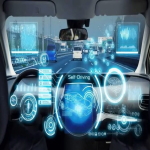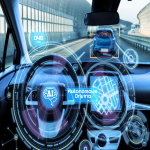Self-driving car
A self-driving car, also known as an autonomous vehicle (AV or auto), driverless car, or robo-car is a vehicle that is capable of sensing its environment and moving safely with little or no human input.
Self-driving cars combine a variety of sensors to perceive their surroundings, such as radar, lidar, sonar, GPS, odometry, and inertial measurement units.
Advanced control systems interpret sensory information to identify appropriate navigation paths, as well as obstacles and relevant signage.

The field of autonomous vehicles is set to grow by 42% within the next four years.

Self-driving vehicles are cars or trucks in which human drivers are never required to take control to safely operate the vehicle.
Also known as autonomous or “driverless” cars, they combine sensors and software to control, navigate, and drive the vehicle.
Levels of driving automation
SAE's automation level definitions:
In SAE's automation level definitions, "driving mode" means "a type of driving scenario with characteristic dynamic driving task requirements (e.g., expressway merging, high-speed cruising, low-speed traffic jam, closed-campus operations, etc.)
Level 0:
The automated system issues warnings and may momentarily intervene but has no sustained vehicle control.
Level 1("hands-on"):
The driver and the automated system share control of the vehicle. Examples are systems where the driver controls steering and the automated system controls engine power to maintain a set speed (Cruise Control) or engine and brake power to maintain and vary the speed (Adaptive Cruise Control or ACC); and Parking Assistance, where steering is automated while speed is under manual control.
The driver must be ready to retake full control at any time.
Lane Keeping Assistance (LKA) Type II is a further example of Level 1 self-driving. Automatic emergency braking which alerts the driver to a crash and permits full braking capacity is also a Level 1 feature, according to Autopilot Review magazine.
Level 2("hands-off"):
The automated system takes full control of the vehicle: accelerating, braking, and steering. The driver must monitor the driving and be prepared to intervene immediately at any time if the automated system fails to respond properly.
The shorthand "hands-off" is not meant to be taken literally – contact between hand and wheel is often mandatory during SAE 2 driving, to confirm that the driver is ready to intervene.
The eyes of the driver might be monitored by cameras to confirm that the driver is keeping their attention to traffic.
Level 3("eyes off"):
The driver can safely turn their attention away from the driving tasks, e.g. the driver can text or watch a movie. The vehicle will handle situations that call for an immediate response, like emergency braking.
The driver must still be prepared to intervene within some limited time, specified by the manufacturer when called upon by the vehicle to do so. You can think of the automated system as a co-driver that will alert you in an orderly fashion when it is your turn to drive. An example would be a Traffic Jam Chauffeur, another example would be a car satisfying the international Automated Lane-Keeping System (ALKS) regulations.
Level 4("mind off"):
As level 3, but no driver attention is ever required for safety, e.g. the driver may safely go to sleep or leave the driver's seat.
However, self-driving is supported only in limited spatial areas (geofenced) or under special circumstances. Outside of these areas or circumstances, the vehicle must be able to safely abort the trip, e.g. slow down and park the car, if the driver does not retake control.
An example would be a robotic taxi or a robotic delivery service that covers selected locations in an area, at a specific time, and in quantities.
Level 5("steering wheel optional"):
No human intervention is required at all. An example would be a robotic vehicle that works on all kinds of surfaces, all over the world, all year round, in all weather conditions.
